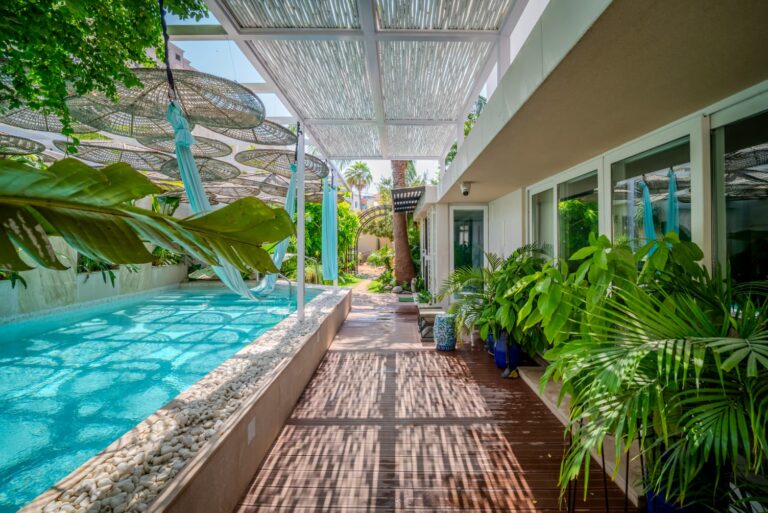The world of modern interior design is fascinating. Creativity knows no bounds here especially when you are learning the art of mixing patterns. So, Today, we’re delving into the art of mixing patterns – a powerful technique that can convert your living spaces into visually appealing masterpieces without spending a fortune. Whether you’re a seasoned interior designer, an architecture or a homeowner, this guide will help you to combine patterns effortlessly and transform your space according to modern interior design techniques.
Understanding the Basics of Mixing Patterns for Modern Interior Design:
Before we dive into the practical tips, let’s establish a foundation. Mixing patterns involves combining different prints, textures, and designs within a space. The key is achieving balance and harmony while avoiding overwhelming the senses. So, let’s get started on how to bring this artistic approach into your interiors.
1. Start with a Foundation:
Every masterpiece begins with a solid base. Choose a neutral colour palette for your walls, floors, and larger furniture pieces. Neutrals act as a canvas, providing a clean backdrop for your pattern play.
2. Establish a Theme:
To maintain cohesion, establish a theme or style for your space. This could be inspired by a particular era, culture, or your personal taste. Modern interior design techniques emphasize on having a theme that will guide your pattern choices and create a cohesive look.
3. Scale Matters:
When mixing patterns, consider the scale of each design. Pair larger prints with smaller ones to avoid overwhelming the space. This ensures a balanced and harmonious visual experience.
4. Choose a Dominant Pattern:
Select one standout pattern to serve as the focal point. This could be a bold wallpaper, a vibrant area rug, or a statement piece of furniture. Let this pattern set the tone for the rest of the room.
5. Stick to a Colour Scheme:
Maintain a cohesive look by sticking to a unified colour palette. Whether it’s through complementary or analogous colours, a consistent colour scheme will tie different patterns together seamlessly.
6. Mix Pattern Types:
Experiment with various pattern types, such as florals, stripes, geometrics, and solids. Incorporating a diverse range of patterns adds depth and interest to your space. Just be sure they share a common colour scheme or theme.
7. Use Solid Colours as Anchors:
Intersperse solid-coloured elements to act as anchors amid the patterns. This helps prevent visual chaos and provides a resting point for the eyes.
8. Pay Attention to Texture:
Patterns aren’t limited to prints – texture plays a crucial role. Mix materials like smooth fabrics, knits, and textured wallpapers to add a tactile dimension to your décor.
9. Embrace the Rule of Odd Numbers:
When arranging patterns, odd numbers tend to create a more visually appealing result. Consider this when choosing pillows, artwork, or other decorative elements.
Practical Modern Interior Design Tips for Mixing Patterns:
Mixing patterns in interior design can add visual interest and personality to a space. However, it’s important to do it thoughtfully to create a cohesive and aesthetically pleasing look. Here are some practical modern interior design tips for mixing patterns:
1. Stick to a Colour Palette:
Choose a cohesive colour palette to tie the patterns together. Stick to a limited range of colours that complement each other, creating a unified look.
2. Scale and Proportion:
Vary the scale of patterns to avoid overwhelming the space. Mix large-scale patterns with smaller ones to create balance. This helps prevent the room from feeling too busy.
3. Mix Pattern Types:
Combine different types of patterns, such as florals, stripes, and geometric prints. Mixing pattern types adds variety and prevents the space from looking too one-dimensional.
4. Maintain a Neutral Base:
Start with a neutral base for larger furniture pieces and walls. This provides a clean canvas for patterns to stand out without competing with each other.
5. Use Solid Colours as Anchors:
Introduce solid-coloured elements to act as anchors in the room. This can include solid-coloured furniture, pillows, or rugs, which provide a visual break between patterns.
6. Consider Texture as a Pattern:
Incorporate textured fabrics as a subtle way to add interest without introducing bold patterns. Textures can include materials like woven fabrics, faux fur, or even textured wallpapers.
7. Limit the Number of Patterns:
Avoid overwhelming the space by limiting the number of patterns. Aim for a balance between patterned and solid elements to maintain a harmonious look.
8. Coordinate Patterns Across Elements:
Repeat patterns across different elements in the room. For example, use a similar pattern in throw pillows, curtains, and upholstery to create a cohesive design.
9. Layer Patterns Gradually:
Start with a primary pattern and layer in additional patterns gradually. This allows you to assess the overall look and make adjustments as needed.
10. Consider Colour Intensity:
Pay attention to the intensity of pattern colours. If one pattern is bold and vibrant, balance it with a more subdued pattern to avoid visual overload.
11. Create Focal Points:
Use patterns strategically to create focal points in the room. This could be achieved through a boldly patterned accent wall, statement furniture piece, or a vibrant area rug.
12. Experiment with Textile Patterns:
Play with various textile patterns, such as on throw blankets, cushions, and drapes. Soft furnishings allow for easy changes if you decide to update the patterns later.
Remember that personal taste plays a significant role in design, so feel free to experiment and find a balance that suits your style. The key is to create a harmonious and visually appealing space that reflects your personality and preferences.
Wrapping Up
Congratulations! You’re now equipped with the knowledge to confidently mix patterns in interior décor. Remember, there are no strict rules – it’s all about using a common sense and finding a balance that resonates with your personal style and align with modern interior design techniques. So, go ahead, experiment, and turn your spaces into uniquely curated works of art. Happy decorating!
Have a look at one of our finest interior design project: Monochrome Lounge






